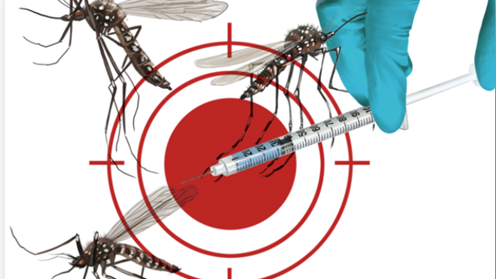Dengue Alert: important to vaccinate!
Brazil has already exceeded 4 million cases of Dengue in 2024. This is four times more than the number of cases registered in the same period last year (902,174) and almost three times the number of cases for the whole of 2023 (1,658,816). This was reported by the Ministry of Health, according to which, as of 29 April, the country had 4,127,571 confirmed infections, the majority of which (761,768) were in the 20-29 age group. In addition, 1,927 deaths have been recorded and a further 2,345 are under investigation. In light of this major Public Health emergency and on the occasion of the just concluded World Immunisation Week, it is all the more important to reiterate the importance of vaccination.

Vector-borne diseases are a major Public Health problem: the World Health Organisation (WHO) estimates that they cause more than 1 billion human cases and 1 million deaths each year, accounting for about 17% of the total cases of communicable diseases.
Of the vector-borne diseases, an important group are the Arboviruses, i.e. viral infections transmitted by arthropods. There are in fact over 100 viruses classified as Arboviruses (from arthropod-borne virus) capable of causing disease in humans.
As described in the National Prevention, Surveillance and Response Plan for Arboviruses (PNA) 2020-2025 (in the appendix), arboviruses, although belonging to different species, have in common the mode of transmission by means of vectors such as phlebotomes, mosquitoes and ticks. Their geographical distribution is quite varied: some are endemic in tropical areas of different continents and occur in Europe with imported cases of disease, others are indigenous even in Mediterranean countries, including Italy.
In particular, in Italy there are both autochthonous arboviruses, including West Nile disease, Usutu virus infection, Toscana virus infection and tick-borne viral encephalitis, and mainly imported arboviruses, such as infections caused by the Chikungunya, Dengue and Zika viruses. Increasingly often, however, both nationally and internationally, we are witnessing epidemic events, some of which are on a significant scale.
In this regard, particularly worrying for Global Public Health is the situation regarding the recent dengue epidemic in Brazil, whose number of cases exceeded 4 million in 2024 (an incidence four times higher than the number recorded in the same period last year - 902,174).
This disease has been known for more than two centuries and is particularly present during and after the rainy season in tropical and subtropical areas of Africa, South-East Asia and China, India, the Middle East, Latin and Central America, Australia and several parts of the Pacific. In recent decades, however, the spread of dengue has increased in many tropical regions, and due to the increased frequency of movement of goods and people, it now also affects the European region along with other countries in the northern hemisphere.
In fact, by 2023, dengue had already spread and greatly affected the health of populations in tropical and subtropical regions, and will likely continue to be a major public health problem in the coming years, presumably also increasingly affecting countries with a temperate climate, including Italy.

* = Data should be interpreted considering differences in reporting rates and case definitions between regions.
Dengue, is an infectious disease of viral origin caused by Dengue virus (DENV), one of the members of the genus Orthoflavivirus, belonging to the family Flaviviridae.
The virus is transmitted to humans, who are the main host, through bites from infected mosquitoes of the genus Aedes: Aedes aegypti is considered the main vector, but Aedes albopictus (the so-called 'tiger mosquito'), although less competent, is also capable of transmitting the infection.
The virus, which is spherical in form and approximately 50 nM in diameter, has a phospholipid bilayer in which the membrane glycoprotein E ('envelope'), the main antigenic determinant that mediates binding to the cell receptor during infection, and the membrane protein M ('membrane') are located.

The phospholipid bilayer and E and M proteins surround the nucleocapsid consisting of a genomic RNA bound to multiple copies of a small basic protein C (capsid). DENV binds to the surface of a host cell and penetrates it by endocytosis.
Once inside, the virus is located inside cell vesicles, the endosomes, from where it releases its genetic material into the cytoplasm following the fusion of its membrane with the endosomal membrane.
The positive polarity of the genome allows it, having entered the target cells, to act as messenger RNA (mRNA), resulting in the synthesis of a polyprotein that is subsequently subdivided into the structural (E, the precursor to protein M (prM) and C) and non-structural (NS) proteins 1, 2A, 2B, 3, 4A, 4B, 5 by the cell's own protease and the viral NS2B-3 protease.
The last of the non-structural proteins to be synthesised, NS5, represents RNA-dependent RNA polymerase (RdRP), which is directly responsible for genome duplication and virus replication. Immature viral particles are then transported through the trans-Golgi network (TGN), where they mature and convert into their infectious form. Mature viruses are then released and can infect other cells.
DENV can infect several cell types in vitro, including epithelial cells, endothelial cells, hepatocytes, muscle cells, dendritic cells, monocytes, bone marrow cells and mast cells. Monocytes and macrophages, derived from patients with severe disease, present viral antigens; erythroid progenitors, megakaryocytes and platelets are also suspected of contributing to viraemia. The cell receptors involved in infection in vivo remain unknown.
Four distinct serotypes of DENV are known (DENV-1, DENV-2, DENV-3, DENV-4) and it is therefore possible to become infected several times with different serotypes, and it is precisely reinfection that is the real problem for Public Health. Subsequent reinfection with a different serotype, in fact, can expose the individual to the risk of developing a serious disease with a potentially fatal outcome. At the root of this increased risk from subsequent reinfection is the phenomenon of ADE (Antibody-Dependent Enhacement) or antibody-dependent enhancement: antibodies produced against one serotype would not be able to neutralise a different serotype, but by binding to it they can facilitate the virus' entry into the cell, thus facilitating infection. Underlying ADE would therefore be a condition of low specificity and low titre antibodies. High antibody titres and specificity would prevent the occurrence of this phenomenon, a rationale to be considered for a possible vaccination strategy.
The most common clinical presentation associated with the disease is fever, headache, acute pain around and behind the eyes, severe muscle and joint pain, nausea and vomiting, skin irritations that may appear on most of the body 3-4 days after the onset of fever, and, in severe cases, encephalitis and haemorrhagic fevers. Typical symptoms are often absent in children. Diagnosis is normally made based on symptoms, but can be more accurately established by searching for the virus or specific antibodies in blood samples.
In this new scenario, the presence of vectors capable of transmitting diseases requires the universal and timely adoption of measures to control these insects and of highly sensitive health surveillance systems, in order to limit the introduction of viruses into our country and/or limit their transmission through competent and efficient vector insects.
The potential for the development of an epidemic, however, does not depend only on the presence of the vector in an area and the density of the infestation, but also on the population's lifestyle habits, the ability of individuals and the community to collaborate in reducing the foci of larval development, the existence of vaccines and the availability and use of individual means of protection against insect bites.
In the prevention of mosquito-borne arboviruses, risk communication, training, information and health education therefore play a decisive role in securing the population's cooperation.
The most effective preventive measure against Dengue is to avoid contact with mosquitoes that carry the virus. Practices such as the use of repellents, appropriate (white) and protective clothing, mosquito nets and curtains therefore become a priority. Furthermore, to reduce the risk of Dengue epidemics, the most effective means is the systematic and continuous control of the mosquito that acts as a vector for the disease. This means eliminating all water stagnation in the vicinity of inhabited areas, and carrying out real pest control campaigns to reduce the Aedes population.
The recent development of a vaccine (with live attenuated virus) immunising against the 4 different serotypes constitutes a new and indispensable tool to combat this disease, although the recommendations for its use are not uniform in different countries. One vaccine, Dengvaxia (Sanofi Pasteur), which is not marketed in Italy, is only indicated for people living in endemic areas and who have had a previous Dengue infection, confirmed through laboratory tests.
In February 2023, the Italian Medicines Agency (AIFA) authorised the use and marketing of a second vaccine, Qdenga (Takeda), a live attenuated tetravalent vaccine for the prevention of Dengue disease caused by any of the four serotypes of the virus. The vaccine also received approval from the European Medicines Agency (EMA) in December 2022.
Following a review of recent literature, the Italian Society of Travel and Migration Medicine (SIMVIM) has therefore formulated a list of indications for the use of this vaccine:
- The vaccine can be administered in all individuals aged ≥ 4 years, seropositive and seronegative for Dengue, without the need for prior serological testing.
- The vaccine is not routinely recommended for all travellers.
- The vaccine may be recommended for trips of at least 3 weeks and/or recurrent trips to endemic or epidemic areas, especially for travellers already seropositive for Dengue.
- The vaccine, however, may be considered for all travellers to endemic or epidemic areas, regardless of serological status (with the traveller being adequately informed that efficacy is lower in the seronegative than in the seropositive).
- If it is not possible to complete the two-dose vaccination cycle before departure, it is still recommended that at least the first dose be administered, reminding the traveller that two weeks are required for protection to begin.
- If the second dose is not administered prior to departure, it should be administered no earlier than three months and ideally within 12 months of the first dose.
- For contraindications, consult the usual indications for all live attenuated vaccines.
At the close of World Immunisation Week (30 April 2024) VaccinarSinSardegna.org once again emphasises the importance of vaccination also with travel medicine in mind. Indeed, in a world where travelling is almost an integral part of human life, with an ever-increasing number of travellers ( alongside the many tourists also workers, students, health workers, the chronically ill, sportspeople, migrants, VFRs - Visiting Friends and Relatives), it is necessary to implement the active and widespread offer of vaccinations and counselling to all travellers in order to prevent infectious risks, disease outbreaks and related sequelae.
Stay connected to our website so as not to miss upcoming updates.



